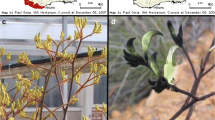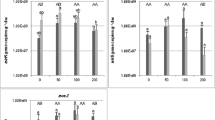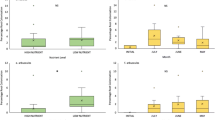Abstract
Three solution experiments were performed to test the importance of NH +4 versus NO -3 +NH +4 to growth of 23 wild-forest and open-land species, using field-relevant soil solution concentrations at pH 4.5. At N concentrations of 1–200 μM growth increased with increasing N supply in Carex pilulifera, Deschampsia flexuosa, Elymus caninus and Bromus benekenii. Geum urbanum was the most N demanding species and had little growth below 200 μM. The preference for NH +4 or NO -3 +NH +4 was tested also at pH 4.0; no antagonism was found between NH +4 and H+, as indicated by similar relative growth in both of the N treatments at both pH levels. Growth in solution with NH +4 relative to NO -3 +NH +4 , 200 μM, was negatively related to the mean pH of the field occurrence of the species tested; acid-tolerant species grew equally well with only NH +4 as with NO -3 +NH +4 (Oxalis acetosella, Carex pilulifera, Festuca gigantea, Poa nemoralis, Deschampsia flexuosa, Stellaria holostea, Rumex acetosella), while species of less acid soils were favoured by NO -3 +NH +4 (Urtica dioica, Ficaria verna, Melandrium rubrum, Aegopodium podagraria, Geum urbanum, Bromus benekenii, Sanguisorba minor, Melica ciliata, Silene rupestris, Viscaria vulgaris, Plantago lanceolata). Intermediate species were Convallaria majalis, Elymus caninus, Hordelymus europaeus and Milium effusum. No antagonism between NH +4 and Ca2+, Mg2+ and K+ was indicated by the total uptake of the elements during the experiment.
Similar content being viewed by others
References
Blacquière T, Voortman E, Stulen I (1988) Ammonium and nitrate nutrition in Plantago lanceolata L and Plantago major L ssp major. Plant Soil 106:23–34
Bogner W (1968) Experimentelle Prüfung von Waldbodenpflanzen auf ihre Ansprüche an die Form der Stickstoffernährung. Mitt Ver Forstl Standortsk Forstpflanzenz 18:3–45
Breteler H (1973) A comparison between ammonium and nitrate nutrition of young sugar-beet plants grown in nutrient solutions at constant acidity. 1. Production of dry matter, ionic balance and chemical composition. Neth J Agric Sci 21:227–244
Brunet J (1994) Interacting effects of pH, aluminium and base cations on growth and mineral composition of the woodland grasses Bromus benekenii and Hordelymus europaeus. Plant Soil 161:157–166
Chaillou S, Morot-Gaudry J-F, Lesaint C, Salsac L, Jolivet E (1986a) Nitrate or ammonium nutrition in French bean. Plant Soil 91:363–365
Chaillou S, Morot-Gaudry J-F, Salsac L, Lesaint C, Jolivet E (1986b) Compared effects of NO −3 and NH +4 on growth and metabolism of French bean. Physiol Veg 24:679–687
Chapin FS, Moilanen L, Kielland K (1993) Preferential use of organic nitrogen for growth by a non-mycorrhizal arctic sedge. Nature 361:150–153
Davidson EA, Stark JM, Firestone MK (1990) Microbial production and consumption of nitrate in an annual grassland. Ecology 71:1968–1975
Falkengren-Grerup U (1992) Soil and floral changes in hardwood forests of southern Sweden (in Swedish with English summary). National Swedish Environment Protection Board, report 4061, Solna
Falkengren-Grerup U (1994) Importance of soil solution chemistry to field performance of Galium odoratum and Stellaria nemorum. J Appl Ecol 31:182–192
Falkengren-Grerup U, Lakkenborg-Kristensen H (1994) Importance of ammonium and nitrate to the performance of herblayer species from deciduous forests in southern Sweden. Environ Exp Bot 34:31–38
Falkengren-Grerup U, Tyler G (1992) Chemical conditions limiting survival and growth of Galium odoratum (L) Scop in acid forest soil. Acta Oecol 13:169–180
Falkengren-Grerup U, Tyler G (1993a) Soil cheical properties excluding field-layer species from beech forest mor. Plant Soil 148:185–191
Falkengren-Grerup U, Tyler G (1993b) Experimental evidence for the relative sensitivity of deciduous forest plants to high soil acidity. For Ecol Manage 60:311–326
Falkengren-Grerup U, Tyler G (1993c) The importance of soil acidity, moisture, exchangeable cation pools and organic matter solubility to the cationic composition of beech forest (Fagus sylvatica) soil solution. Z Pflanzenernähr Bodenkd 156:365–370
Findenegg GR (1987) A comparative study of ammonium toxicity at different constant pH of the nutrient solution. Plant Soil 103:239–243
Gigon A, Rorison IH (1972) The response of some ecologically distinct plant species to nitrate- and to ammonium-nitrogen. J Ecol 60:93–102
Grauer UE, Horst WJ (1990) Effect of pH and nitrogen source on aluminium tolerance of rye (Secale cereale L) and yello lupin (Lupinus luteus L). Plant Soil 127:13–21
Hackett C (1965) Ecological aspects of the nutrition of Deschampsia flexuosa (L) Trin. II. The effects of Al, Ca, Fe, K, Mn, N, P and pH on the growth of seedlings and established plants. J Ecol 53:315–333
Jackson LE, Schimel JP, Firestone MK (1989) Short-term partitioning of ammonium and nitrate between plants and microbes in an annual grassland. Soil Biol Biochem 21:409–415
Johansen A, Jakobsen I, Jensen ES (1993a) Hyphal transport by a vesicular-arbuscular mycorrhizal fungus of N applied to the soil as ammonium or nitrate. Biol Fertil Soils 16:66–70
Johansen A, Jakobsen I, Jensen ES (1993b) External hyphae of vesicular-arbuscular mycorrhizal fungi associated with Trifolium subterraneum L. 3. Hyphal transport of 32P and 15N. New Phytol 124:61–68
Klotz F, Horst WJ (1988) Effect of ammonium- and nitrate-nitrogen nutrition on aluminium tolerance of soybean (Glycine max L). Plant Soil 111:59–65
Kpodar PM, Latché JC, Cavlaié G (1992) Répercussions d'une alimentation azotée ammoniacale sur le metabolisme carboné photosynthétique chez le soya (Glycine max L Merr). Agron Paris 12:265–275
Kurvits A, Kirkby EA (1980) The uptake of nutrients by sunflower plants (Helianthus annuus) growing in a continuous flowing culture system, supplied with nitrate or ammonium as nitrogen source. Z Pflanzenernähr Bodenkd 143:140–149
Le Tacon F, Timbal J, Valdenaire JO (1982) Influence de la forme d'azote minéral sur la croissance d'éspèces herbacées forestières. Acta Oecol 3:307–318
Neitzke M (1990) Einfluß von Ammonium- und Nitratstickstoff auf die Entwicklung von Buchenjungpflanzen. Z Pflanzenernähr Bodenkd 153:225–228
Read DJ, Leake JR, Langdale AR (1989) The nitrogen nutrition of mycorrhizal fungi and their host plants. In: Boddy L, Marchant RJ, Read DJ (eds) Nitrogen, phosphorus and sulphur utilization by fungi. British Mycological Society, Cambridge, UK, pp 181–204
Rorison IH (1985) Nitrogen source and the tolerance of Deschampsia flexuosa, Holcus lanatus and Bromus erectus to aluminium during seedling growth. J Ecol 73:83–90
Rosnitschek-Schimmel I (1982) Effect of ammonium and nitrate supply on dry matter production and nitrogen distribution in Urtica dioica. Z Pflanzenphysiol 108:329–341
Runge M (1983) Physiology and ecology of nitrogen nutrition. In: Lange DL, Nobel PS, Osmond CB, Ziegler H (eds) Physiological plant ecology. III. Response to the chemical and biological environment. (Encyclopedia of plant physiology, new series, vol 12C) Springer, Berlin Heidelberg New York, pp 163–200
Ruzika J, Hansen EH (1981) Flow injection analysis. Chemical analysis. Wiley, New York
Shen L, Foster JG, Orcutt DM (1990) Influence of nitrate and ammonium on the growth and 2,4-deaminobutyric acid composition of flatpea (Lathyrus sylvestris L). Plant Cell Environ 13:833–838
Schimel JP, Jackson LE, Firestone MK (1989) Spatial and temporal effects on plant-microbial competition for inorganic nitrogen in a California annual grassland. Soil. Biol Biochem 21:1059–1066
Westling O (1989) Deposition of atmospheric pollutants in Scania (in Swedish). (Report) Swedish Environment Research Institute Stockholm, pp 1–14
Author information
Authors and Affiliations
Rights and permissions
About this article
Cite this article
Falkengren-Grerup, U. Interspecies differences in the preference of ammonium and nitrate in vascular plants. Oecologia 102, 305–311 (1995). https://doi.org/10.1007/BF00329797
Received:
Accepted:
Issue Date:
DOI: https://doi.org/10.1007/BF00329797




